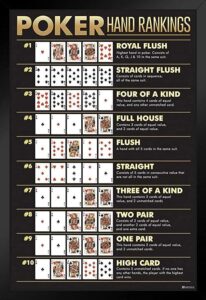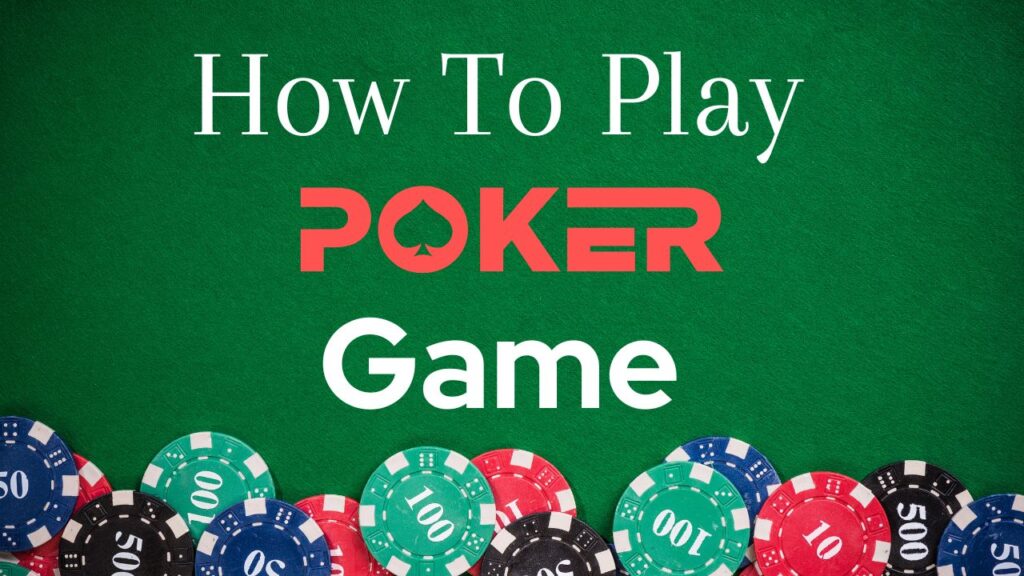Introduction : How To Play Poker Game
Playing poker involves a combination of skill, strategy, and luck. There are various forms of poker, but one of the most commonly played versions is Texas Hold’em. Here’s a basic guide on how to play Texas Hold’em poker How To Play Poker Game
Objective: The primary objective in poker is to win chips or money by either having the best hand at showdown or convincing other players to fold their hands.

Setup:
- Blinds: The game starts with two players posting forced bets called the small blind and big blind. The player to the left of the dealer posts the small blind, and the next player posts the big blind.
- Hole Cards: Each player is dealt two private cards (hole cards) that belong to them alone.
Betting Rounds: The game consists of several betting rounds. Here’s an overview of the key stages:
- Pre-flop: Players examine their hole cards and decide whether to bet, call, or fold. The betting starts with the player to the left of the big blind.
- Flop: Three community cards are dealt face-up in the middle of the table. Another round of betting occurs, starting with the player to the left of the dealer.
- Turn: A fourth community card is dealt, followed by another round of betting.
- River: A fifth and final community card is dealt, and the final round of betting takes place.
Showdown: If more than one player remains after the final betting round, a showdown occurs. Players reveal their hole cards, and the best hand is determined based on the combination of hole cards and community cards.
Hand Rankings: Understanding poker hand rankings is crucial. Here’s a brief overview from the highest to lowest ranking hands:
- Royal Flush
- Straight Flush
- Four of a Kind
- Full House
- Flush
- Straight
- Three of a Kind
- Two Pair
- One Pair
- High Card
Winning the Pot: The player with the best hand at the showdown wins the pot. If there is a tie, the pot is split among the winning players.
Key Actions:
- Bet: Place chips into the pot.
- Call: Match the current bet.
- Raise: Increase the current bet.
- Fold: Discard your hand and forfeit the round.
Tips for Beginners:
- Learn Hand Rankings: Understand the hierarchy of poker hands.
- Start with Strong Hands: As a beginner, focus on playing strong starting hands.
- Pay Attention to Position: Your position at the table influences your strategic decisions.
- Practice Patience: Avoid playing too many hands, especially weak ones.
- Study Opponents: Observe your opponents’ playing styles and adapt your strategy accordingly.
There are several different variations on the core game of poker. We’ll get into these different poker types later, but each shares a number of common threads.
The main objective of poker is to use the cards you’re dealt to create the best five-card hand possible – or to convince other players that you have the best hand, even if you don’t!
Poker card rankings:
The cards in a deck are individually ranked, from top to bottom:
A, K, Q, J, 10, 9, 8, 7, 6, 5, 4, 3, and 2.
When you’re creating your best hand of five cards, you’re usually looking to make a:
- Straight Flush
- Four of a Kind
- Full House
- Flush
- Straight
- Three of a Kind
- Two Pair
- Pair
Some Fundamental Poker Strategies
Certainly! Here are some fundamental poker strategies that can help you improve your game, especially in Texas Hold’em, one of the most popular variants:
- Starting Hand Selection:
- Be selective with the hands you play. Focus on playing strong starting hands such as high pairs (e.g., AA, KK), high cards of the same suit (e.g., AK suited), and consecutive cards (e.g., 10-J suited).
- Position Awareness:
- Your position at the table is crucial. Play tighter (more selective) in early positions and consider playing a wider range of hands in later positions. This allows you to react to opponents’ moves.
- Reading Opponents:
- Pay attention to your opponents’ playing styles. Look for patterns in their betting, check, and raise behaviors. Adjust your strategy based on the information you gather.
- Pot Odds and Implied Odds:
- Understand pot odds to make informed decisions about whether to call, raise, or fold. Additionally, consider implied odds, which involve estimating potential future bets to determine if a call is profitable.
- Aggressive Play:
- In general, playing more aggressively can be effective. Aggression puts pressure on opponents and can force them to make mistakes. However, balance aggression with careful decision-making.
- Bluffing:
- Bluff sparingly and strategically. Choose the right opponents and situations for bluffing. Effective bluffing requires a good understanding of your opponents and the ability to read their potential hands.
- Bankroll Management:
- Set limits on the amount of money you are willing to risk in a session or tournament. Proper bankroll management helps ensure you can withstand losses and continue playing.
- Table Image:
- Be aware of your own table image. If opponents perceive you as too tight, consider mixing in some aggressive plays. If they see you as too loose, tighten up your play when needed.
- Adaptability:
- Be adaptable and willing to adjust your strategy based on the dynamics of the game, the playing styles of opponents, and the changing circumstances of each hand.
- Focus and Patience:
- Maintain focus and patience throughout the game. Avoid tilting (emotional reactions to losses) and stay disciplined in your decision-making.
Conclusion :How To Play Poker Game
Remember that poker is a game of skill, and improving your understanding of strategy and psychology can enhance your gameplay over time. It’s also crucial to be aware of the specific rules of the poker variant you are playing, as different variations have distinct rules and nuances.

